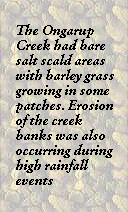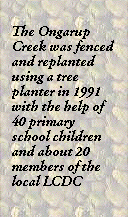
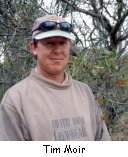
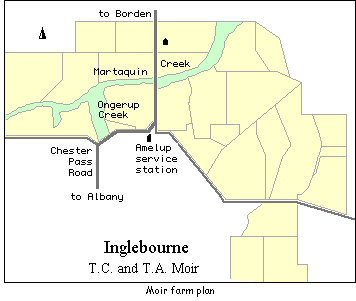 The Site
The Site
Inglebourne farm straddles Chester Pass Road to the north, east and southeast of the Amelup Service Station. Tim Moir has lived on the farm all his life and started working on the farm after leaving school in 1975. The land was settled and cleared in the early 1900s. The Martaquin Creek starts just outside the northern boundary of the Stirling Range National Park as Paper Collar Creek. It runs through the property in a northeasterly direction into the Pallinup River, which is just outside the northeast property boundary. The Ongarup Creek runs into the Martaquin Creek to the west of the Amelup Service Station.
The Problem
Over-grazing was degrading the Martaquin Creek, to the west of the Chester Pass Road. Prior to being fenced off the riparian zone consisted of a few large yate trees, sheoaks, paperbarks and rushes.
The Ongarup Creek had bare salt scald areas with barley grass growing in some patches. Erosion of the creek banks was also occurring during high rainfall events.
An area adjacent to the Pallinup River on the northeastern boundary was severely eroded during a major flood in 1958 and much of the topsoil was lost down the river.
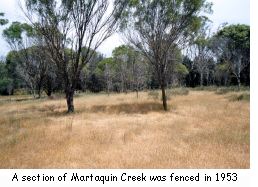 The Solution
The Solution
A deep drain was constructed west of the Chester Pass Road by machine in 1989 and the highly saline water has drained constantly ever since into the Martaquin Creek to the north.
The portion of Martaquin Creek to the east of Chester Pass Road was fenced in 1953 and the vegetation has regenerated naturally. It mostly consists of sheoak (Casuarina) with a sparse shrub understorey, and there are signs of natural regeneration.
Tim decided to fence and revegetate the rest of the creeks to arrest the vegetation decline and he also wanted to leave the farm in better condition than when he took over. The portion of Martaquin creek to the west of Chester Pass Road was fenced in 1990 and allowed to regenerate. Sheoak is regrowing well in parts. Where regeneration was slow the corridor was scalped, deep ripped and direct seeded and also a tree planter was used in 1992. This was supplemented later with hand seeding. The direct seeding included salt and semi salt tolerant local species of Acacia, Casuarina, Eucalyptus, Hakea, Kennedia, Melaleuca and Callistemon.
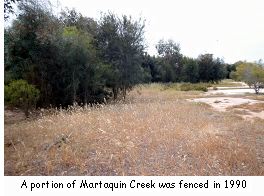 The Ongarup Creek was fenced and replanted using a tree planter in 1991 with the help of 40 primary school children and about 20 members of the local LCDC.
The Ongarup Creek was fenced and replanted using a tree planter in 1991 with the help of 40 primary school children and about 20 members of the local LCDC.
An area to the northwest of the eroded area adjacent to the Pallinup River was fenced and replanted with trees in rows approximately 20 metres apart in 1992.
The Outcomes and Observations
Since the fencing and revegetation Tim has noticed that the creeklines are becoming stabilised and erosion has decreased. Regeneration is occurring naturally and the various plantings are surviving well to date. Tim believes that the most successful method of revegetation has been scalping and direct seeding.
Martaquin Creek Catchment Statistics
| Type of watercourse: | Ephemeral creek with semi-permanent pools | |
| Average rainfall: | 380 mm./year | |
| Water quality: | Saline | |
| Catchment disturbances: | Stock grazing, cropping |
